Here are two of the constraints and guidelines that the common cards of most modern Magic sets abide by:
- Core sets have 2 vanilla common creatures in each color.
- Almost every card should conceivably play a role in some kind of strategy.
On their own, they seem inconsequential, but taken together they are actually very constraining. Most colors asides from Green don't have a variety of sizes to choose from. For example, Red and Black can usually only get a 2/1 or 3/2 for vanilla slots of casting cost 3 or less.
The creature curve of each color should be as varied as possible, so we don't want a curve like a 2/1 vanilla in the 2-drop slot followed by a 3/2 vanilla in the 3-drop slot in the same color — that's boring. A 4-drop 4/3 followed by a 5-drop 5/3 would also feel like it could use more variety. What this boils down to is that each color is likely to get one small vanilla and one large vanilla so that the vanilla creatures of that color are spread out across the curve.
Another constraint is that we don't want a creature in one color to be too similar to a creature in the same casting cost in another color. For example, if we give Red a vanilla 2/1 as its "small vanilla," then we don't want to also give Black a 2/1.
So in most core sets, you would ask, "OK, in this set does Red get the 2/1, or does Black get the 2/1? Whichever doesn't get the 2/1 gets the 3/2."
There could be many exception cases, and in fact I started this article by writing them out, but that looked like it would make the article hard to read so I omitted them. Of course some sets might have a vanilla 1/1 matter for some strategy by having it count as a Snow Permanent or be a Hybrid-colored creature to enable color triggers. Maybe with power creep red could get a RR 3/1. Some funky set could have a RRR 3/3 or 3/4, who knows. If it's not a core set, there's less pressure to show the basic character of these colors and defensive sizes like 2/3 would be more acceptable for Red and Black.
But here I just wanted to point out that for most practical purposes, many parts of the skeleton boil down to some kind of "either/or" choices. If these parts are spotted early, they can be filled out first. Otherwise, you may start filling out other parts first and come across a situation where you want to add a vanilla creature to fulfill the quota but you can't do so without cutting a creature elsewhere that was starting to get interwoven into the set.
So this is our current common creature curve for Red and Black:
The first thing I notice is that Muck Rat doesn't play a role in an archetype. I'd like to cut it and put in either a 2/1 or 3/2. Otherwise, the higher end of the curve for Black isn't so rich with vanilla sizes that I could design multiple vanillas that are different from each other. (I don't want a 4-drop 4/2 or 5/1 followed by a 5-drop 4/3). The 3/1 Greataxe Mercenary isn't indispensable by any means, so we can still give either Red or Black a 2/1 and the other color a 3/2.
Another thing to notice (which I talked about in a previous post) is that all of our 2-drops provide power 2 on the board. Replacing one of the 2-drops with a vanilla 2/1 isn't enough; some of the other 2-drops also need to be changed to something that doesn't have power 2.
So it's Sudoku time. If you were to cut one of the 2-drops, what would you cut?
I tried cutting the Eerie Nosferatu and replacing it with a 2/1 vanilla. The 1/1 vanilla Muck Rats are also gone and require a replacement.
Another constrained spot to design for is 1-drops that have a useful role. There are fewer abilities that are balanced and make sense on a 1-drop. Here, I tried to adapt the Eerie Nosferatu by changing the ability a bit.
Or, maybe there can be a one-drop that you can pay mana and sacrifice to get a Duress effect.
Now I need to change Scourge of the Seas to a guy that isn't power 2.
Since one of my goals with this set's development is to have a contrast between aggro vs control, it might actually be ok to ignore the rule that creatures in the same casting cost should not all be aggro attackers. We could ignore this rule only for 2-drops, since they are so important for aggro decks. However, I decided for this example that I would like to do that only in a few colors like Green and White, and Red already has an aggro boost just by having Kird Ape as well as another playable 1-drop. I decided not to do it with Black.
I found it's a pity that I have to cut Scourge of the Seas since it looks like a card that could inspire aggro versions of Black-Blue or Black-Red decks. But I replaced it with this:
In a Red-Black deck, this card would encourage you to burn the opponent's blockers so you can attack with a +2/+1 bonus. Now that I think about it more, while this card may mold players' play styles the way I want it to, it's not necessarily the most likable card as you can't turn it on at will. It might feel fun to get the rider bonus whenever you kill something with removal before combat, but it might be just as frustrating when you can't. If it had a bigger size to begin with, maybe players could be more happy about the infrequent bonus more. Also, it doesn't help UB aggro decks as much as it helps RB aggro decks.
Another card I consider is this:
I think it's likable and grokkable as a basic vampire bat. There is another flying, lifelinking guy at 4cc, but I think it's so good that it's detracting attention from the Bond creatures like Vaportrail Imp so I would consider replacing it for this smaller sized one.
Bloodthrone Vampire might also be good here, if Dragon Fodder is staying in Red.
Pirates are a subtheme in our set, so after this swapping out the Scourge of the Seas, we might need to find another card that could be concepted as a Pirate card so that there will be at least one common black Pirate.
Now, which 2-drop should be replaced in Red?
I kind of like the play of turn 1 Kird Ape into turn 2 Runaway Chariot, an archetype defining play for hyper-aggro RG decks in our testing so far. Runaway Chariot's "drawback" makes you commit to picking up more and more Giant Growths and Auras, making you play in a different way than a typical midrange RG deck.
But I also like how Goblin Shortcutter helps Runaway Chariot, and how it allows aggro decks to get past defensive walls. In this set, I'd like to try out having more defensive options for control decks including high toughness creatures, balanced by more ways to get past them such as Goblin Shortcutter.
And finally, Dragon Fodder is also valuable since there is some kind of budding sacrifice strategy.
There are lots of ways to do this. We could replace Goblin Shortcutter with some version of Crossway Vampire. (We might need to reconcept the card since vampires haven't been Red in core sets.) Or we could replace both the Shortcutter and the Chariot with Fervent Cathar.
One of the cards I'd like to replace the power 2 guys is this:
While I want the RG aggro deck to be less explosive than it is now, I also want it to have ways to continue fighting after the opponent has started to stabilize. This card gives you a free draw every turn if your hand is empty, so it gives aggro decks hope in the late game.
Also, Dragon Fodder could be replaced with this:
Also, either of these could be costed at R; if the Swindler turns out to be too strong at that cost, the activation cost could be raised. That would push out the Goblin Arsonist; but perhaps Blisterstick Shaman could be put in at 3cc to maintain the number of pinging effects.
I went with no changes in the 1-drop range, and the 2-drops are Runaway Chariot, Goblin Shortcutter, and Goblin Swindler, with no token producing effects.
It may have been better to have a 2/1 vanilla in Red rather than Black. (Or to have 3 black 2-drops, one of them the Scourge of the Seas?) So what would happen in that case?
For black, I would keep Scourge of the Seas and possibly replace Eerie Nosferatu with Thirsty Vampire, or Bloodthrone Vampire if the sacrifice deck is supported. I would put the adapted Eerie Nosferatu in the 1-drop slot. We would be putting the vanilla 3/2 in Black, so something has to budge; probably the Cadaver Imp which could turn into old-fashioned Gravedigger.
For red, I would replace Goblin Shortcutter with the vanilla 2/1, then replace the vanilla 3/1 with a Crossway Vampire variant like this:
The ability could also be, "When this enters the battlefield, creatures can't be blocked by only one creature this turn."
Dragon Fodder gets replaced with Goblin Swindler. Unfortunately, I can't seem to find room for token generation unless I cut Goblin Arsonist's pinging effect or Runaway Chariot's hyper-aggro-ism. Perhaps the Runaway Chariot and Ruckus Raiser can be consolidated into Fervent Cathar so that a token-producing card can be in the 2-drop slot once more.
The Black curve still feels a bit off at some points — The 2-drop slot probably shouldn't be entirely evasive creatures. In the 3-drop slot, a turned-on Scorched Shambler and Barony Vampire look kind of similar. Perhaps the Scorched Shambler can be a 1B 1/1 Skeleton that becomes a 3/1 when you control a Mountain.
As I did this exercise, the effects also spread to other costs and into other colors like Blue, but I can't cover it all in detail. One of the things that spread the changes to Blue was that if I give one color a high-power evasive creature in a certain casting cost, I can't put a high-power evasive creature of the same converted mana cost in another color.
There are some constraints that I haven't satisfied, such as having a french vanilla version of most basic creature keywords. For example, Runaway Chariot doesn't qualify because it also has the "must attack" ability. There needs to be a creature with just "haste" on it, as such cards are good teaching tools. Perhaps we need to bend this rule for this set though, because the Bond creatures are already producing a lot of designs that are similar to French vanillas (in terms of what they do, not their complexity) that it would be a strain to have more such designs and less abilities such as enter the battlefield effects or tap abilities.
I hope this exercise demonstrates the nature of this process, namely:
- Things change a lot, by necessity.
- Every change spawns a whole chain reaction of changes.
Secondly, everything in the set depends on everything else. You can't look at a card and tell if it's going to be in the set just by itself; it could depend on something external like whether the vanilla 2/1 went to Red or Black. (Unless the card is central to the set in some way.)
So although time is running short, the focus of testing should still be on what archetypes are going to be supported, and how the influence of Bond can be made most meaningful. Any detailed tweaking that is done before deciding on that will be lost if the set structure changes (such as how many aggro 2-drops a color gets) based on how we want Bond to play out.

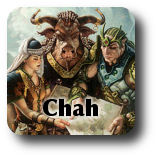

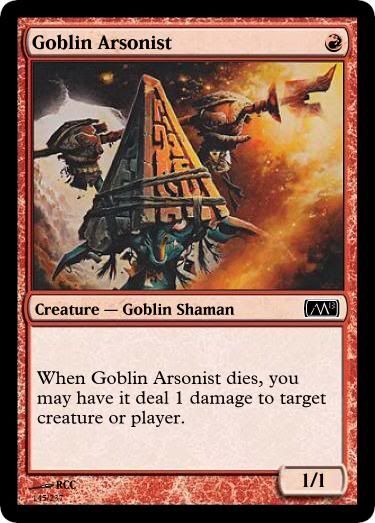
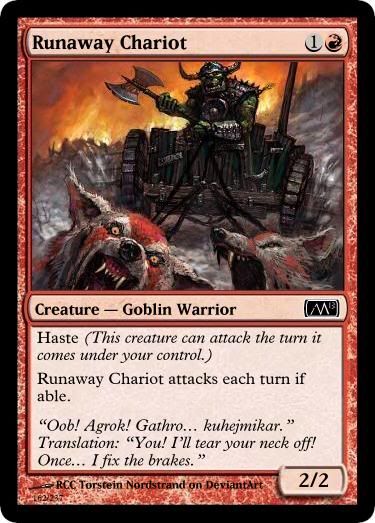

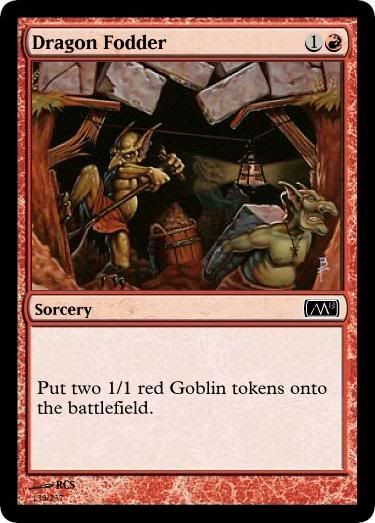
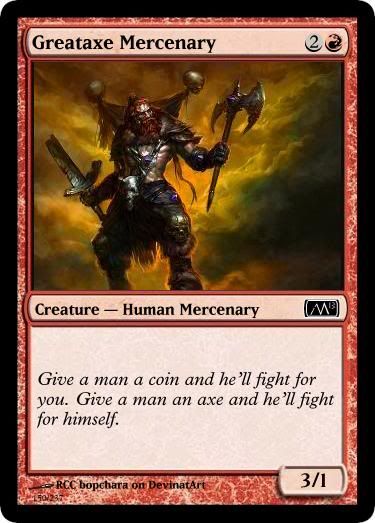
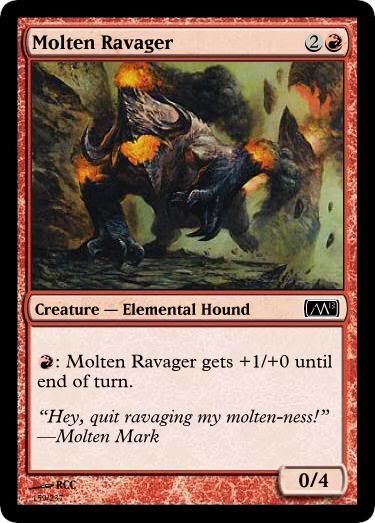


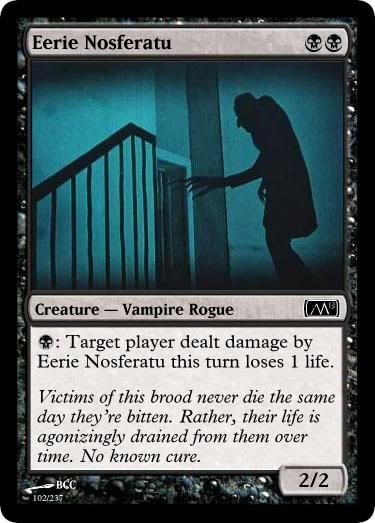








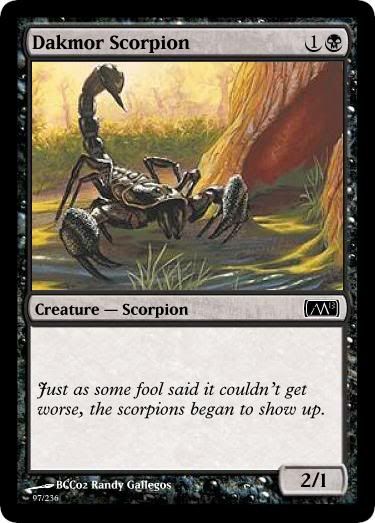

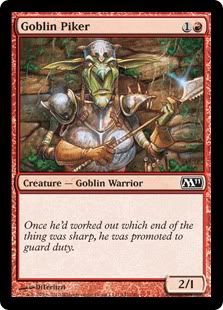

There's a lot going on here, and I'm sure you've spent a lot of time on it, but I'd pull just a few things out, just in case they're relevant.
ReplyDeleteI think Muck Rats does more work than is obvious. Its primary role, by a large margin, is to be a vanilla 1/1 with a distinctive and flavorful identity. It's good to have vanilla 1/1s. You may hate Eager Cadets and Fugitive Wizards, but they're an important part of Magic. A brand new player coming to magic will get "oh, these are rats. 1/1s. Got it." But within the framework of the set, Muck Rats are also an immediate answer to Scourge of the Seas (and Greataxe Mercenary). Scourge enables the black evasive aggressive archetypes to exist - black is the nexus for evasive aggression in M13, and I don't for one second have a problem with that. In the past, that's occasionally been white but regularly been blue, but here, intimidate plays a role that formerly has been filled almost exclusively by Flying.
Similarly, Greataxe Mercenary is a vanilla creature that can trade one-for-one with Howling Silverback, or any of the other x/3s in the set.
I strongly disagree that the Confessor (3B flying lifelink) is putting Vaportrail Imp in its shadow.
"if I give one color a high-power evasive creature in a certain casting cost, I can't put a high-power evasive creature of the same converted mana cost in another color" seems like an unecessary if not outright unhelpful restraint. This might be a point we'd disagree on, but I would say Rishadan Airship and Vaportrail Imp have amazing synergy.
I disagree with the idea that there is a french vanilla quota that Runaway Chariot fails to achieve, but the card *is* an update to Goblin Chariot, which is always an option.
There's always more, but time is sadly short. Any chance that *you* could post your current and/or planned skeleton?
I'll see if I can't find time to draw up the other colors and post a comprehensive iteration later tonight.
I definitely think Rishadan Airship will look too similar to Vaportrail Imp. I'd rather change it to Cloud Elemental and support aggro by putting in more cards like Frost Breath that help aggro decks sustain attacks rather than having multiple power 3 evasive guys at 3cc.
DeleteI could be wrong about Sengir Confessor, but this is about exploring playstyle first, the viability of specific cards like Confessor later. I'm trying to figure out a style of drafting where I feel that the draft definitely hinges around cards like Vaportrail Imp. For the sake of exploration, I'm going to start with a version where anything that *might* compete with Bond creatures such as Airship or Confessor are removed. Once I know what that Bond style is and how it plays like, I can start making choices about whether Confessor belongs in the set or not and carefully add them back in.
By the way, the reason Confessor feels balanced now might be because everything has on-curve power (in terms of P/T) and there are lots of power-3 evasion creatures everywhere. That might be an interesting paradigm (like Zendikar) but if testing shows that not having such high amounts of power (in terms of P/T) and evasion brings out the specialness of Bond more, then Confessor might turn out to be unbalanced in that environment. We can't test individual cards right away, we have to test the overall style of the set first.
I agree that the build with Scourge of the Seas is better.
I see the defensive trading roles the vanilla guys are playing, but the replacement cards I posted also serve that role. I get to keep the Scourge of the Seas in if I put the 2/1 in Red and the 3/2 in Black, so I'd prefer that configuration. (There could also be some other way where Red gets a 4-drop 3/3 vanilla and a 6-drop 6/4 vanilla so that they don't feel too similar to each other. Or there could be a build where Black gets one more 2-drop so that it has room for both a vanilla 2/1 and Scourge of the Seas. That's worth considering.)
I'm pretty sure the Runaway Chariot fails to achieve the French quota, but I'm not sure how absolutely final the French requirement is as long as the set is simple overall, so I'm thinking of running away with the Runaway Chariot choice.
I'll try to post my current skeleton later today. I've had a nagging feeling something wasn't right with it yet, even for testing, so I hadn't posted it. Writing this actually helped to clear up what that was. When I post it, please criticize any parts you don't like, and let's try out alternate builds as well. I have a feeling playtesting extremely different builds can help us learn through contrast what configurations lead to what kind of play environment. Although I'm worried about the number of times we'll need to draft them to develop that feel.
Another solid article, Chah. Thanks.
ReplyDeleteThirsty Bat was a version of Sengir Confessor we had discussed and that I think is a solid card too. We went with the Confessor with the idea that we'd switch if it proved too good, but it's always nice to have a few obviously strong creatures, but trying out the bats seems fine too.
I am curious to see what other changes this caused because we're now missing a four-drop and a recursion spell in black? Gravedigger? As you point out, these changes affect numerous other things and we can't really judge the merits of this without understanding the other changes it necessitates.
I like Goblin Swindler too. I like him best at 2cc, but I could see 1cc if we up his activation cost, as you said.
What's the difference, from this bird's eye view, between Goblin Shortcutter + Greataxe Mercenary and Goblin Piker + Ruckus Raisers? They're the same effects, virtual vanilla bodies, same costs, same reprint count, but one has a reprint people love and the other one people hate. Why switch them?
I didn't think a 3/2 and 3/1 were different enough. My reasoning was, if we put a 3/x vanilla in Red, we can't have a 3/x vanilla in Black. Since Black needs to have both a small vanilla and a large vanilla (otherwise sizes like 4cc 4/2 and 5cc 4/3 are too similar to each other), if it can't have a 3/x as its small vanilla, it has to use the 2/1 size as its small vanilla. That would push out Scourge of the Seas, but Scourge is currently doing a good job of inspiring an aggro RB deck and an aggro RU deck (colors that are usually controlling). So in order to keep Scourge we need to have the Red's small vanilla be a 3/x.
DeleteHowever, if push comes to shove maybe it's possible to ignore the similarity of a 3/1 and a 3/2. But I think Crossway Vampires was bad only because of the double Red mana cost, and because there weren't good 2-drops in the Red deck (aside from the swingy Neonate). In this set a 2R crossway vampires should be awesome.
I really want to keep Scourge of the Seas, but I'm not sure that the last skeleton you presented is workable. Both Vaportrail Imp and Scorched Shambler have differences, but both can also play just like Barony Vampire a fair portion of the time.
ReplyDeleteAlso, I do really like the idea of giving red a looter, but I'm not sure it needs to offer card advantage. could we print:
R
T, Discard a card: Draw a card.
1/1
at common?
I've been giving the skeleton another go because of that reason; the black 3-drops are all very similar.
DeleteI'm sure the looter where you discard as a cost is what WotC has in mind for most Red looters. However, I'm trying to put in more ways for aggro decks to keep fighting after a control deck has stabilized. I don't want to make it so that if the aggro deck didn't win by a certain turn, the game drags on with the control deck in perfect control. I want to make it so that once the control deck is in control, it has to win in a hurry.
That said, it might be too easy to draw a card per turn, I just want to try it out like this to see how it works out.
If we do Goblin Swindler (which I'm not a huge fan of but would definitely get behind), what Blue looting are we doing at common?
DeleteDo we want a traditional Merfolk Looter to show contrast? The saboteur-looter Courier bird we have now? Or, no common blue looting?
In the community set on Alex's multiverse we had a similar red ": discard a card, draw a card" (that triggered off attacking). I think the consensus was that (a) having red do discard, then draw looting that turns into "hellbent -- draw a card" is probably a good thing to give red aggro decks some staying power but (b) the way it was phrased would probably be confusing to some players, who would expect the discard to be a cost. We weren't sure of the best answer.
DeleteHere are two more possible black swaps:
ReplyDelete1: Acolyte of Xathrid 0/1, Muck Rats 1/1
2: Scourge of the Seas 2/1, Thirsty Bat 1/1
3: Vaportrail Imp 3/1, Scorched Shambler 2/2
4: Gravedigger 2/2, Drifting Shade 1/1
5: Mass of Ghouls 5/3, Band of Thieves 3/3
1: Nightshade Stinger 1/1
2: Scourge of the Seas 2/1, Bloodthrone Vampire 1/1, Scorched Shambler (as skeleton) 1/1
3: Vaportrail Imp 3/1, Scathe Zombies 2/2
4: Gravedigger 2/2, Drifting Shade 1/1
5: Mass of Ghouls 5/3
6: Band of Thieves 4/3
I like this list best IF you can accept having a 2/1 vanilla and a 2/1 with + and - in the same color/cost/rarity.
Delete1: Acolyte of Xathrid 0/1
2: Scourge of the Seas 2/1, Dakmor Scorpion 2/1, Thirsty Bat 1/1,
3: Vaportrail Imp 3/1, Scorched Shambler 2/2
4: Gravedigger 2/2, Dross Crocodile 5/1
5: Nightwing Shade 1/1, Band of Thieves 3/3
That's a very great build. Maybe Dakmor Scorpion can be Diregraf Ghoul, although I'm not sure how canon a 2/2 is.
DeleteI've been thinking that Vaportrail Imp could be a 3B 2/2 lifelink vampire that gains flying with Islands, Scorched Shambler could be a 3B 4/2 that gains haste with Mountains. These sizes will give players an "experience." ("I'm gaining 2 life through the air every turn!" or "I caught the opponent off guard while his creatures were tapped! Take 4!") I'd also like to see a 6cc 6/4 Wurm that gains haste, something Green fatties should have done all along. Zooming in for 6 will be quite a new and fun experience in Limited.
DeleteI think the current stats we have are super elegant, and they look "right" both before and after they turn on, but they also just give us familiar vanilla or french creatures for a discount of 1. Attacking with a 3/1 Vaportrail Imp gives us almost the same experience as attacking with a Skywinder Drake. If this was a supporting mechanic in a multicolor set, I could understand it, but as the main attraction, it's lacking and I can understand the critiques that some people like George Gone have been making.
The Vampire version with lifelink will be a bit more complex than a "vanilla to french vanilla" version, but it is so resonant to have flying and lifelink on a Vampire that it won't be hard on players' minds.
The haste version of the Zombie means you need to have drawn a Mountain out of your 4 lands when you cast it, but that's an easy requirement. I'm getting the feeling that this 4/2 zombie (whether it's haste or +2/+0) will do its best in a focused RB deck anyways. You don't want to turn it on with a splashed Mountain like you would with the evasive Bond guys; you need it on curve. It will require a focused RB deck with heavy removal in order to attack, since it looks like the 2-drops in other colors are going to have more power 2 guys than usual and opponents are more likely to have blockers up. I don't think requiring a Mountain upfront will be too harsh for this zombie.
I'm thinking that Plains Bond should be +0/+3, and if we do that, Forest Bond won't be the only one that gives a stat bonus.
I hate everything you're saying here, and think that even with all the people we have at our disposal, it would take more time than we have to bring the set to a remotely balanced (in terms of numbers) point if you go forward with them.
DeleteThat said, I can't really comment *astutely* without a skeleton proposed.
Could you more specifically explain what you expect or desire from the Bond cards altogether (and/or their roles in the set, mentally and in Limited)?
For now, though, I'd say that we did consider Haste, but it plays differently from all the Bonds. You seem to be comfortable with that, but I'm not. If we *can* make it so that Bond isn't worthless after the first turn, then we should, and +2/+0 does that well. I can't think of any designs that are interesting, elegant, or fun from +0/+3, so if you have any, I'd be eager to see them. +1/+2 and +2/+0 mirror each other fairly well; +1/+2 and +0/+3 don't feel particularly different at all.
Diregraf Ghoul is not vanilla.
Your entire post seems to me to be a good argument FOR Muck Rats. The set as a whole isn't perfect (and we can definitely do some work on the two drops) but throwing in Barony Vampire and changing both black Bond creatures is not an approach I can find any merit. You've proven that it's a complex thing to fit in vanilla creatures and make a set's numbers work; I contend that Muck Rats *is* the answer to that very long and complex question. But again, I'm getting ahead of myself.
Diregraf Ghoul is not a vanilla, but Walking Corpse is, and you can guess what I mean.
DeleteMuck Rats is terrible. We didn't choose it as any kind of answer, we chose it because we designed the other cool cards first without checking the constraints and planning the slots. It isn't an answer, it's copping out on trying to solve this.
What I'd like from the Bond cards is like I said, to give people new play experiences, not Streetbreaker Wurm, Esper Comerants, and Daggerclaw Imp, etc. Those cards weren't even the highlights of their sets. The Bond cards might add strategic considerations in the deckbuilding stage, but they don't give us any new _play_ experiences.
We need to take a step back and try to see how other players might see it. I don't have a full 360 view but we can't just brush off comments that the Bond cards look boring. Don't get defensive about something before we've even tried out alternatives.
I'll try to get a skeleton up soon.
We've got about three weeks left to work with. I think the set will be better if we focus on changes we have confidence in, rather than exploring new paths or those we've already been done. Even if we found a better path, we wouldn't have the time to refine it into something of quality. While we certainly can't ignore criticisms of bond, this team and this community has put a stupendous amount of thought into it already and no decision has been made lightly or impetuously.
DeleteWe didn't go with haste as one of our keywords for the same reason we're not using any enters-the-battlefield effects: The thing that makes bond cards unique is that you "can pay the other color" later and upgrade your creature then, unlike strict multicolor or kicker.
While +0/+3 isn't exciting, it's strong enough to have an impact, but the P/T boost that we're locked into is +1/+2 which is WAY too similar. At this point, the only bond ability change that I'd seriously consider is reverting vigilance to first strike, because vigilance hasn't been amazing and we already have an idea how first strike would work in the set. (To be clear, I think vigilance has been better for us than first strike.)
As much as I love Vaportrail Imp exactly how it is, I'd be willing to try a vampiric version with lifelink. That would break the no-other-abilities guideline at common, but I don't know that's wrong. If we go that route, we can give Druid of the Glade reach.
As the "returning keyword" of the set, bond does have big shoes to fill and maybe it comes a touch short, but please don't get in the mindset that bond alone must carry the set. If bloodthirst was all M12 had going for it, it would've been miserable. M11 has just five scry cards and it was a deep and enjoyable format. Yes, we want bond to be fun, but we can not rest the fate of the set on bond's shoulders.
It's also important to remember the purpose of bond. There's a reason we're using it in a core set and not an expert set. It's a soft introduction to multicolor. It's meant to be easier and safer to use than gold, while hinting at the power of multiple colors. It also teaches the color alliances and enemies. If you try to make it do more, it will fail. If you need more from the set, add more to the set.
I feel that we have to try out alternatives and make changes responding to feedback in order for improvement to happen. Although we put a lot of thought into it over several months, it's been a lot of theory work and we've discarded many alternatives based on theory alone. For example, "Haste only matters on the first turn" sounds good in words, but if you play out the games in your mind, a hasted 6cc 6/4 Wurm creates way more exciting moments than a 5cc 6/4. In a race between a fatty deck and a flyers deck that has ETB bounce effects and removal Auras, haste does more to shape the dynamics of the game than costing 1 less. My hunch is that even one test would make that clear.
DeleteIn a way, the tweaking we've been doing without actually testing the alternatives is still a kind of "refinement," but we shouldn't be stuck on those results.
Although just changing the vigilance guys and changing the Elephant's base stats from 2/3 to 3/2 alone will do a lot to make Bond look less boring already, I think the haste change and Lifelink Vampire change will make them even more memorable.
I don't think the +0/+3 bonus will feel similar with +1/+2 because these of the creatures I intend to put it on:
+1/+2 bonus:
Kird Ape
Elephant: 3W 3/2 Elephant that becomes 4/4.
These are very aggressive and meaty guys.
+0/+3 bonus:
Sacred Sapling (1G 1/1, "T: add G to your mana pool" gets +0/+3 with Plains.)
Castleback Turtle (4U 3/3, gets +0/+3 with Plains)
These are very defensive guys and they help their respective decks exist. (WG Fatty and Flyers&Walls) I don't think they'll cause a stall problem with the Zendikar-style aggro tools in the set.
The ability to listen to feedback and set aside your ego while considering it is critical to game design. What you hear less often is that the vast majority of your players will never understand your design as well as you do (or you've failed to create a deep game) and so you also have to know which feedback to disregard or reinterpret. Consider MaRo's recent response that players will always want a creature to be bigger or a spell to be cheaper, but that doesn't make it the best thing for the game. This is an *extremely* difficult line to walk, and a big part of what makes game design challenging/interesting.
DeleteI'm suggesting that while bond will cause some excitement thanks to choices like making Kird Ape a common, its primary role is not to be splashy but to be a workhorse. It is meant to quietly pull players into allied color pairs as well as into archetypes. It's doing that very well. Vaportrail Imp screams to be played in a UB flying deck and Hillside Charger screams to be played in a RG fatty/ramp deck. That's phenomenal. We've created 5-10 archetypes (archetypes that new players can readily identify!) with ten simple commons. Don't underestimate that accomplishment.
Yes, these cards don't often create tense gameplay moments (though every single one is capable of it), but that is not that their purpose. Did scry ever make you nervous how a combat step would play out? No. Was it a failure? No. Scry was a deck-smoothing mechanic. It did that well and nothing else. If Wizards had tried to make Scry create tense combat, they would have failed. Was M11 boring without the returning keyword affecting combat? No.
We can't throw away a mechanic that is serving its purpose so well just because it doesn't serve every purpose the set requires. These are comfy sandals, not combat boots. Don't steel-tip the toes.
I finally got an alternate version ready for exploring what play revolving around Bond can be like. Let's draft both versions to contrast how they feel different, what's working and what's not.
DeleteIs there a reason that each color needs to have the same curve? Can't there be some colors that have a glut of two drops or three drops? When I say glut, I guess I mean 4 or so each.
ReplyDeleteGiven each color a full 1CC to 6CC curve makes it easy to play mono color. But if Red, for example, has to dip into Black for it low CC creatures to build a viable aggro deck, isn't that good?
And don't some colors fill there curve in with other types of spells, like Auras, Instants and Artifacts?